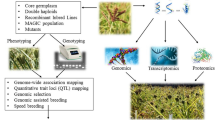Abstract
Milling performance is an important attribute for desi chickpea and other pulses, as varieties that are more difficult-to-mill lead to processing yield loss and damage to the resulting split cotyledons (dhal) such as chipping and abrasion which are unattractive to the consumer. Poor milling performance leads to poor dhal quality and therefore lower prices and profitability along the pulse value chain. The Pulse Breeding Australia Chickpea Program identified near-isogenic desi lines that differed in seed shape and milling yields, however it was unknown whether this was due simply to a difference in physical forces on the seed during milling, mediated by seed shape, or whether there were underlying differences in chemical composition that could explain these differences. The two isolines differed in the composition of their seed coat, cotyledons and adjoining surfaces. Some of these differences were in agreement with previous research on composition of easy- and difficult-to-mill samples. These differences suggest that biochemical adhesive or cohesive mechanisms at the interface of seed tissues involve pectic polysaccharides and lignin-mediated binding.


Similar content being viewed by others
References
Agrawal K, Singh G (2003) Physico-chemical and milling quality of some improved varieties of chickpea (Cicer arietinum). J Food Sci Technol (Mysore) 40:439–442
Bhattacharyya M, Martin C, Smith A (1993) The importance of starch biosynthesis in the wrinkled seed shape character of peas studied by Mendel. Plant Molec Biol 22:525–531
Black RG, Singh U, Meares C (1998) Effect of genotype and pretreatment of field peas (Pisum sativum) on their dehulling and cooking quality. J Sci Food Agric 77:251–258
CCD Official Method 02-03 (2003) Dumas (combustion) total nitrogen determination. In: Cereal Chemistry Division (ed) Official testing methods of the Cereal Chemistry Division, 4th edn. R. Cereal Chemistry Division of the Royal Australian Chemical Institute, North Melbourne
Choct M, Hughes RJ, Annison G (1999) Apparent metabolisable energy and chemical composition of Australian wheat in relation to environmental factors. Aust J Agric Res 50:447–451
Hamilton DA, Davies PJ (1988) Mechanism of export of organic material from the developing fruits of pea. Plant Physiol 86:956–959
Inc Milestone (2000) Milestone application note 032. Milestone Inc., Shelton
Knights EJ, Wood JA, Harden S (2011) A gene influencing seed shape of desi type chickpea (Cicer arietinum L.). Plant Breed 130:278–280
Lanquar V, Lelievre F, Bolte S, Hames C, Alcon C, Neumann D, Vansuyt G, Curie C, Schroder A, Kramer U, Barbier-Brygoo H, Thomine S (2005) Mobilization of vacuolar iron by AtNRAMP3 and AtNRAMP4 is essential for seed germination on low iron. EMBO J 24:4041–4051
Lobreaux S, Briat JF (1991) Ferritin accumulation and degradation in different organs of pea (Pisum sativum) during development. Biochem J 274:601–606
Marschner H (2002) Mineral nutrition of higher plants, 2nd edn. Academic Press, San Diego
Outen GE, Beever DE, Fenlon JS (1976) Direct methylation of long-chain fatty acids in feeds, digesta and faeces without prior extraction. J Sci Food Agric 27:419–425
Scott RW (1979) Colorimetric determination of hexuronic acids in plant materials. Anal Chem 51:936–941
Singh U, Santosa BAS, Rao PV (1992) Effect of dehulling methods and physical characteristics of grains on dhal yield of pigeonpea (Cajanus cajan L.) genotypes. J Food Sci Tech, India 29:350–353
Subba Rao GV, Ito O, Berry WL, Wheeler RM (2003) Sodium—a functional plant nutrient. Crit Rev Plant Sci 22:391–416
Thorne MJ, Thompson LU, Jenkins DJA (1983) Factors affecting starch digestibility and the glycemic response with special reference to legumes. Am J Clin Nutr 38:481–488
van Soest PJ (1963) Use of detergents in the analysis of fibrous feeds. II. A rapid method for the determination of fiber and lignin. J Assoc Off Agric Chem 46:829–835
Wang N (2008) Effect of variety and crude protein content on dehulling quality and on the resulting chemical composition of red lentil (Lens culinaris). J Sci Food Agric 88:885–890
Wood JA, Knights EJ, Harden S (2008) Milling performance in desi-type chickpea (Cicer arietinum L.): effects of genotype, environment and seed size. J Sci Food Agric 88:108–115
Wood JA, Knights EJ, Harden S, Choct M (2012) Milling performance and other quality traits are affected by seed shape in isogenic lines of desi chickpea (Cicer arietinum L.). J Agric Sci 4:244–252
Wood JA, Knights EJ, Campbell GM, Choct M (2014a) Differences between easy- and difficult-to-mill chickpea (Cicer arietinum L.) genotypes. Part I: broad chemical composition. J Sci Food Agric 94:1437–1445
Wood JA, Knights EJ, Campbell GM, Choct M (2014b) Differences between easy- and difficult-to-mill chickpea (Cicer arietinum L.) genotypes. Part II: protein, lipid and mineral composition. J Sci Food Agric 94:1446–1453
Wood JA, Knights EJ, Campbell GM, Choct M (2014c) Differences between easy- and difficult-to-mill chickpea (Cicer arietinum L.) genotypes. Part III: free sugar and non-starch polysaccharide composition. J Sci Food Agric 94:1454–1462
Wood JA, Knights EJ, Campbell GM, Choct M (2014d) Erratum to: differences between easy- and difficult-to-mill chickpea (Cicer arietinum L.) genotypes. Part I: broad chemical composition. J Sci Food Agric 94:3305–3306
Acknowledgements
The authors acknowledge Shuyu Song (University of New England, Armidale) and Catherine Keir (NSW Department of Primary Industries, Tamworth) for technical assistance and Steven Harden and Bruce McCorkell (NSW Department of Primary Industries, Tamworth) for statistical analysis.
Author information
Authors and Affiliations
Corresponding author
Electronic supplementary material
Below is the link to the electronic supplementary material.
Rights and permissions
About this article
Cite this article
Wood, J.A., Knights, E.J., Campbell, G.M. et al. Near-isogenic lines of desi chickpea (Cicer arietinum L.) that differ in milling ease: differences in chemical composition. J Food Sci Technol 54, 1002–1013 (2017). https://doi.org/10.1007/s13197-016-2483-6
Revised:
Accepted:
Published:
Issue Date:
DOI: https://doi.org/10.1007/s13197-016-2483-6




